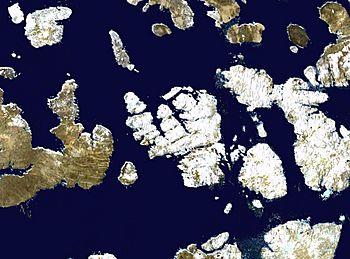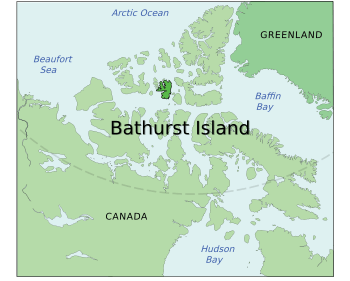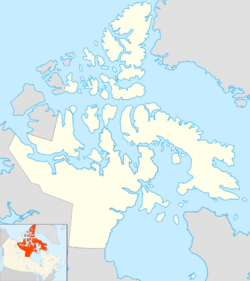Bathurst Island (Nunavut) facts for kids

Satellite photo montage of Bathurst Island and its neighbours
|
|

Location of Bathurst Island
|
|
| Geography | |
|---|---|
| Location | Northern Canada |
| Coordinates | 75°46′N 099°47′W / 75.767°N 99.783°W |
| Archipelago | Queen Elizabeth Islands Canadian Arctic Archipelago |
| Area | 16,042 km2 (6,194 sq mi) |
| Area rank | 54th |
| Length | 117 mi (188 km) |
| Width | 63–94 mi (101–151 km) |
| Administration | |
| Territory | Nunavut |
| Demographics | |
| Population | 0 |
Bathurst Island is a large island located in Nunavut, Canada. It is part of the Queen Elizabeth Islands and the Canadian Arctic Archipelago. The island covers about 16,042 square kilometers (6,194 sq mi). This makes it the 54th largest island in the world and the 13th largest in Canada.
Bathurst Island is about 185 to 188 kilometers (115 to 117 mi) long. Its width varies from 101 to 150 kilometers (63 to 94 mi). No people live on the island permanently.
Most of the island is quite flat, with few areas higher than 330 meters (1,083 ft). The highest point is Stokes Mountain, which reaches 412 meters (1,352 ft). This mountain is part of the Arctic Cordillera mountain range. The island has good soil, which helps a lot of plants grow. This also means there are more animals living there compared to other Arctic islands.
Bathurst Island is home to two important natural areas. These are Polar Bear Pass, an International Biological Program site, and Qausuittuq National Park.
Contents
Discovering Bathurst Island
Early Inhabitants
People first lived on Bathurst Island around 2000 BC. These were early native groups known as the Independence I culture. Later, other groups like Independence II, Pre-Dorset, and Dorset cultures also lived there.
Around the year 1000 AD, Thule people lived at Brooman Point Village on the eastern coast. This might have been during a time when the climate was warmer. When Europeans first arrived in the 1800s, no modern Inuit lived on the island. However, Inuit people in the region likely knew about the island's many animals. They probably visited for hunting trips.
European Exploration
The first European to find Bathurst Island was William Edward Parry in 1819. He mapped its southern coast. The island was named after Henry Bathurst, 3rd Earl Bathurst. He was a British government official from 1812 to 1827.
Later, other explorers mapped more of the island. Robert Aldrich charted much of the west coast in 1851. George Henry Richards and Sherard Osborn mapped the north coast in 1853.
Research and the Magnetic Pole
During the 1960s and 1970s, the Earth's North Magnetic Pole moved across Bathurst and Seymour Islands. In 1973, the Canadian National Museum of Natural Sciences set up a research station on the island. This station was located on the Goodsir River in Polar Bear Pass. It was staffed by scientists during certain seasons until the 1980s.
See also
 In Spanish: Isla de Bathurst (Canadá) para niños
In Spanish: Isla de Bathurst (Canadá) para niños



